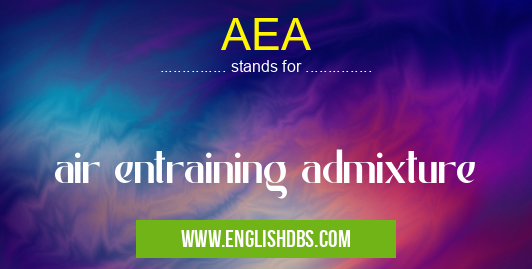What does AEA mean in UNCLASSIFIED
Air entraining admixtures are substances added to concrete, cement and grout mixtures during mixing or curing to produce microscopic air bubbles. These bubbles help to improve the workability and durability of the mix by preventing cracking due to freezing temperatures or drying conditions. When added properly, AEA can give a concrete mixture better workability, improved freeze-thaw durability and enhanced strength.

AEA meaning in Unclassified in Miscellaneous
AEA mostly used in an acronym Unclassified in Category Miscellaneous that means air entraining admixture
Shorthand: AEA,
Full Form: air entraining admixture
For more information of "air entraining admixture", see the section below.
What is AEA?
AEA is a type of admixture used in concrete, mortar and grout mixtures that helps form tiny air bubbles in the mix. These microscopic bubbles help to reduce tensions caused by changing temperatures or drying conditions. This reduces the likelihood of cracking and improves the overall performance of a mixture, providing better workability and strength for a longer period of time.
Benefits
When used correctly, AEA can significantly enhance cement-based products like concrete,mortar, and grout mixes. By introducing tiny air pockets into the mix, they provide better workability while also increasing freeze-thaw durability. Additionally, these admixtures help strength development with no need for extra water or materials making them an economical choice for many projects. Overall this leads to improved product life expectancy and cost savings in the long run.
Essential Questions and Answers on air entraining admixture in "MISCELLANEOUS»UNFILED"
What is an air entraining admixture?
An air entraining admixture (AEA) is a chemical additive that helps promote tiny air bubbles in concrete. This can increase the concrete's freeze-thaw durability and make it more resistant to physical and chemical damage caused by freezing and thawing.
How does AEA work?
AEAs contain surfactants that lower the surface tension of water in concrete, enabling small air bubbles to form. These air bubbles help break up large clusters of cement particles, increasing plasticity and workability as well as improving its strength.
What are the benefits of using AEA?
The most significant benefit of using an AEA is improved durability due to its increased resistance to freeze-thaw cycles, but it also increases the concrete's workability, plasticity, and strength. Moreover, AEAs can also reduce bleeding, segregation and shrinkage issues in fresh concrete mixtures.
What types of AEAs are available?
There are two main types of AEAs - liquid and powder form additives. Liquid AEA's are easier to use but may require other admixtures for additional benefits while powder forms offer greater flexibility because they often come mixed with other admixtures or filler materials such as sand or fly ash.
What should be taken into consideration when using AEA?
Before using an AEA, you should check that there is enough room in your ready-mix truck or container for the product's volume since adding too much may disrupt the cement paste's optimum consistency. Additionally, be aware that AEAs tend to reduce early-strength gains over time so plan accordingly with your mix design mix design if strength at early ages is required.
How much AEA should be used?
The amount of AEA that should be used will depend on your application requirements as well as any applicable standards for AEAs in your region or industry. Generally speaking, 0.2% - 0.4% by weight per 1 sack (94 lbs) of cement is recommended for most applications though this range may vary depending on environmental conditions and other factors related to your project..
Does AEA have any limitations?
Yes, despite its many advantages, AEAs do have some limitations to consider before use such as reduced early strengths gains over time or potential incompatibility with certain admixtures like superplasticizers which can result in poor performance when combined together.
What happens if too much AEA is added to a mix?
Adding too much AEA can cause excessive foaming resulting in poor compressive strength values or even slump loss due to disruption of the cement paste's consistency.
Is there a test I can perform to determine if my mixture has sufficient AEA?
Yes — Air Content Test ASTM C 173/C 173M can measure how much entrained air is present within a hardened concrete sample which indicates whether an adequate amount of entrained air was added during the mixing process.
Final Words:
Air entraining admixtures are an easy way to increase performance with minimal additional cost involved in concrete,mortar and grout mixes. By introducing small air pockets into a mixture it helps make it more durable over time as well as providing better workability when first mixing it up for installation. Used correctly these admixtures can be an invaluable tool on many construction project sites.
AEA also stands for: |
|
| All stands for AEA |
